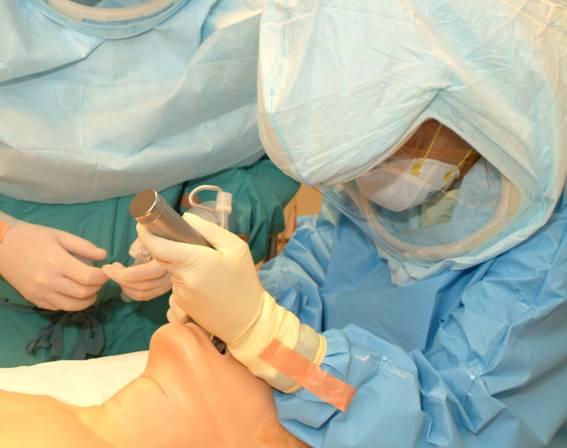
Mount Sinai Hospital Critical Care Unit
SARS Resources
 | Main Page |
 | Protected Code Blue |
 | Personal Protection Systems |
 | Educational Resources |
 | Links & Literature |
Stryker T4 Personal Protection System

These systems use fans built into a helmet to circulate air underneath a hood made of filter material. Air circulates through the hood filter to ensure a continuous fresh supply of filtered air and removal of carbon dioxide from under the hood. Combination gown/hoods are available. The hood filter is disposed after use which eases decontamination of equipment.
Using the Stryker T4 Personal Protection System For High-Risk Procedures During SARS Outbreaks
You should note the following points when viewing this presentation:
- ALERT!!!
Please note the following recommendations for removing Stryker gear...these
are different than the previously posted presentation.
- When inserting power plug into battery, only tape loosely...ensure battery is not located too far back to reach!!!
- Before removing Toga, turn off helmet fan by pulling cord out of battery pack by grasping through Toga. This will prevent blowing any contaminated air over the face after the filter hood is removed. Although the risk of the previous procedure is low because the wearer is far from the patient during gear removal, this recommended change seems to be a safer approach.
- Concerns about adequacy of Stryker
T4 System for protection against SARS
- Some clinicians have raised concerns about the adequacy of the Stryker T4 System based on particulate counts inside the T4 hood during testing. Any suspended particulate in air trapped by the hood when first placed would not be cleared by the T4 system; this is due to the fundamental difference in technology between this system and traditional PAPR devices. As long as the hood is put on in a non-infected environment (i.e., not in the patient room), the retained particle count should not be of concern. Stryker has conducted additional indepedent testing of their device and has presented their data to health authorities in Hong Kong. At issue is whether the filter can block viral particles and whether contaminated particles can somehow get around the filter and into the hood environment. Thus far the data reviewed seems to alleviate these concerns. If possible, the raw information will be posted/linked on this site in the near future. In the meantime, remember that this device is an ADJUNCT protective device designed to provide additional barrier protection during high risk procedures. Full appropriate personal protective gear should be worn underneath, including an N95 or better respirator, eye protection, gowns etc. Also realize that no personal protective equipment is certified by FDA or NIOSH to prevent SARS transmission. This site will be updated with any further information or conclusions based on the review of the system in Hong Kong or other sites.
- Report
from Stryker on repeat testing of their T4 Personal Protection System by
an independent laboratory.
- Our thanks to Stryker for giving permission to post this on our website.
- Use of plastic to store helmets
when not in use
- Some have raised the concern that the helmets may get moist if plastic is used and humidity is present. Any material that will keep the helmets clean when not in use is appropriate.
- Should booties or foot coverings
be worn?
- There has not been consensus on this issue between hospital infection control teams. Downside to booties is that many people contaminate themselves when removing them. It is likely acceptable to not wear booties, as long as you are wearing clogs/shoes that can easily be contaminated by wiping/spraying their surface with virox or other disinfectant, and scrub suits that you will change after your shift or if any observable contamination. The long toga may also protect your feet from downward spread of contaminated secretions etc. Consult with your local infection control team for guidance and local preference.
- Time required to put on Stryker
T4 Protection System
- Depending on your familiarity with the system it takes between 30 seconds to 1.5 minutes. Proper inservicing with observed practice donning and removing equipment is essential. Refresher training sessions will also be necessary to prevent decay of learning.
- Other person required to remove
hood/toga?
- Our group found that it was safe for the wearer to remove the hood/toga by him/herself once the back ties were released. We felt this should be done far away from assistants wearing standard gear. Other groups have created protocols using another person to help remove the hood/toga. Either approach is acceptable, be aware that you are balancing the need for careful removal of the gear to avoid spread of droplets with close proximity of other personnel putting them at greater risk.
- Changing inner layer of protection
after removal of Stryker T4 System
- Don't forget to change your inner gown, clean your goggles/glasses and replace your mask with a new N95/N100 mask after the Stryker gear is removed (we forgot to include that step in the last slide!!!).
- Storage of SARS gear
- We recommend that all SARS adjunct protective gear be stored in some easily noticed cart. In addition to the Stryker gear, don't forget to have goggles or glasses with shields, surgical gloves (to extend over gown sleeves), hand alcohol wash, bonnets, extra masks, extra gowns, etc. There should be enough for all team members plus a few extras in case of error.
For further information contact: Dr. Randy Wax, Education Director
Room 1831, Mount Sinai Hospital, 600 University Avenue, Toronto, Ontario, Canada M5G 1X5
This site is hosted by the Technology Application Unit